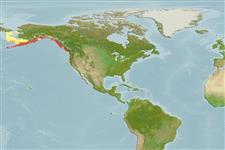Common names from other countries
>
Perciformes/Cottoidei (Sculpins) >
Agonidae (Poachers) > Hemitripterinae
Etymology: Nautichthys: Greek, nautes = sailor + Greek, ichthys = fish (Ref. 45335); oculofasciatus: Nautichthys sailor fish, in allusion to the sail-like first dorsal fin; oculofasciatus eye-banded (Ref. 4930).
More on author: Girard.
Environment: milieu / climate zone / depth range / distribution range
Ecologia
marinhas demersal; intervalo de profundidade ? - 110 m (Ref. 2850). Temperate; 66°N - 34°N
Eastern Pacific: St. Lawrence Island, Alaska to San Miguel Island, southern California, USA. Possibly occurring in Japan (Ref. 2850).
Tamanho / Peso / Idade
Maturity: Lm ? range ? - ? cm
Max length : 20.0 cm TL macho/indeterminado; (Ref. 2850)
Descrição suscinta
Chaves de identificação | Morfologia | Morfometria
Espinhos dorsais (total) : 8 - 9; Raios dorsais (total) : 27 - 30; Espinhos anais: 0; Raios anais : 18 - 20. Caudal fin rounded, directed upward (Ref. 6885). Color variable, gray above with dark markings and obscure dusky bands, paler below; spinous dorsal darker; other fins except pelvic fins diagonally streaked darker; sometimes red flecks on rayed dorsal and on eyes; a very distinct black band running diagonally down and back through eye (Ref. 6885). A recognizable variant occurs in Knight Inlet, British Columbia - the first caudal fin is dominated by the II, III, I rather than the first four spines and the whole fin is frail and when removed from fluid appears more like a mast than a sail (Ref. 6885).
Occurs inshore and to 110 m depth, mostly on rocky bottoms and areas with algae (Ref. 2850). Nocturnal (Ref. 6885). May be found upside down against roofs of crevices (Ref. 6885). Swims with its dorsal fin extended in front of its head (Ref. 6885). Eggs deposited in late winter or spring (Ref. 6885).
Ciclo de vida ou comportamento de acasalamento
Maturities | Reprodução | Spawnings | Egg(s) | Fecundities | Larvas
Eschmeyer, W.N., E.S. Herald and H. Hammann, 1983. A field guide to Pacific coast fishes of North America. Boston (MA, USA): Houghton Mifflin Company. xii+336 p. (Ref. 2850)
Status na Lista Vermelha da UICN (Ref. 130435)
CITES (Ref. 128078)
Not Evaluated
Ameaça para os humanos
Harmless
Uso pelos humanos
Pescarias: espécies comerciais; Aquário: Aquários públicos
Ferramentas
Relatórios especiais
Baixar XML
Fontes da internet
Estimates based on models
Preferred temperature (Ref.
115969): 4.1 - 10.8, mean 7.1 (based on 212 cells).
Índice de diversidade filogenética (Ref.
82804): PD
50 = 0.6289 [Uniqueness, from 0.5 = low to 2.0 = high].
Bayesian length-weight: a=0.00501 (0.00197 - 0.01276), b=3.15 (2.93 - 3.37), in cm Total Length, based on LWR estimates for this (Sub)family-body shape (Ref.
93245).
Nível Trófico (Ref.
69278): 4.1 ±0.68 se; based on food items.
Resiliência (Ref.
120179): médio(a), tempo mínimo de duplicação da população 1,4 - 4,4 anos (tm=1).
Fishing Vulnerability (Ref.
59153): Low vulnerability (10 of 100).
